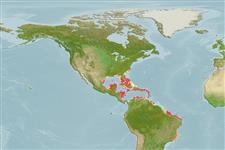Common names from other countries
Environment: milieu / climate zone / depth range / distribution range
Écologie
marin récifal; profondeur 3 - 30 m (Ref. 9710). Tropical
Western Atlantic: southeastern Florida, USA and Bahamas to Brazil.
Taille / Poids / Âge
Maturity: Lm ? range ? - ? cm
Max length : 15.0 cm TL mâle / non sexé; (Ref. 26340)
Épines dorsales (Total) : 5; Rayons mous dorsaux (Total) : 8 - 9; Épines anales: 3; Rayons mous anaux: 32 - 34. Ventral profile deeply curved in front of anal fin, tapering upward to slender caudal peduncle. Mouth very oblique (Ref. 26938). Scales ctenoid along the back posterior to dorsal fin and ventrally on head and body, otherwise cycloid, coppery with a dark band at base of anal fin; young nearly transparent, silvery over abdomen (Ref. 13442).
Occurs in clear water with coral bottom. Form aggregations in dark crevices and caves (Ref. 9710). Nocturnal (Ref. 9626). Its name probably refers to the juveniles, which are so transparent that the backbone can be seen in the living fish (Ref. 26938). Feeds on zooplankton, particularly the larval stages of invertebrates (Ref. 13442).
Life cycle and mating behavior
Maturities | Reproduction | Spawnings | Egg(s) | Fecundities | Larves
Robins, C.R. and G.C. Ray, 1986. A field guide to Atlantic coast fishes of North America. Houghton Mifflin Company, Boston, U.S.A. 354 p. (Ref. 7251)
Statut dans la liste rouge de l'IUCN (Ref. 130435)
CITES (Ref. 128078)
Not Evaluated
Menace pour l'homme
Harmless
Utilisations par l'homme
Pêcheries: d'intérêt potentiel; Aquarium: potentiel
Outils
Articles particuliers
Télécharger en XML
Sources Internet
Estimates based on models
Preferred temperature (Ref.
115969): 25 - 28.1, mean 27.4 (based on 656 cells).
Phylogenetic diversity index (Ref.
82804): PD
50 = 0.5000 [Uniqueness, from 0.5 = low to 2.0 = high].
Bayesian length-weight: a=0.01413 (0.00715 - 0.02792), b=2.98 (2.80 - 3.16), in cm Total Length, based on LWR estimates for this species & Genus-body shape (Ref.
93245).
Niveau trophique (Ref.
69278): 3.1 ±0.0 se; based on diet studies.
Résilience (Ref.
120179): Haut, temps minimum de doublement de population inférieur à 15 mois (Preliminary K or Fecundity.).
Fishing Vulnerability (Ref.
59153): Low vulnerability (10 of 100).
